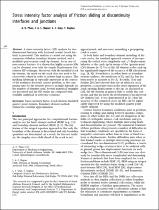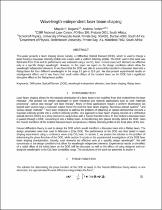 ResearchSpace
ResearchSpace
Effects of finite element formulation on optimal plate and shell structural topologies
JavaScript is disabled for your browser. Some features of this site may not work without it.
- ResearchSpace
- →
- Research Publications/Outputs
- →
- Journal Articles
- →
- View Item
| dc.contributor.author |
Long, Craig S

|
|
| dc.contributor.author |
Loveday, Philip W

|
|
| dc.contributor.author |
Groenwold, AA

|
|
| dc.date.accessioned | 2009-09-15T14:10:17Z | |
| dc.date.available | 2009-09-15T14:10:17Z | |
| dc.date.issued | 2009-09 | |
| dc.identifier.citation | Long, CS, Loveday, PW and Groenwold, AA. 2009. Effects of finite element formulation on optimal plate and shell structural topologies. Finite Elements in Analysis and Design, Vol. 45(11). pp 817-825 | en |
| dc.identifier.issn | 0168-874X | |
| dc.identifier.uri | http://hdl.handle.net/10204/3594 | |
| dc.identifier.uri | https://www.sciencedirect.com/science/article/pii/S0168874X09000948 | |
| dc.identifier.uri | https://doi.org/10.1016/j.finel.2009.06.027 | |
| dc.description | Copyright: 2009 Elsevier. This is the author's version of the work. It is posted here by permission of Elsevier for your personal use. Not for redistribution. The definitive version was published in the journal, Finite Elements in Analysis and Design, Vol. 45(11), pp 817-825 | en |
| dc.description.abstract | The effects of selected membrane, plate and flat shell finite element formulations on optimal topologies are numerically investigated. Two different membrane components are considered. The first is a standard 4-node bilinear quadrilateral, and the other is a 4-node element accounting for in-plane (drilling) rotations. Plate elements selected for evaluation include the discrete Kirchhoff quadrilateral (DKQ) element and two Mindlin–Reissner-based elements, one employing selective reduced integration (SRI), and the other an assumed natural strain (ANS) formulation. The effect of hourglass control on SRI elements is also evaluated. The flat shell elements consist of an assemblage of these membrane and plate components. The Mindlin–Reissner elements are shown to recover the thin plate result computed using DKQ elements. However, optimal topology is shown to be dependent on plate element formulation as thickness increases. Furthermore, a new benchmark problem is introduced illustrating the deficiencies of Mindlin–Reissner elements employing SRI without hourglass control. For shell problems, elements which properly account for in-plane rotations are shown to be insensitive to the penalty parameter which enforces the relationship between in-plane rotations and displacements, in contrast to the situation when an ad hoc treatment of drilling degrees of freedom is used. | en |
| dc.language.iso | en | en |
| dc.publisher | Elsevier | en |
| dc.subject | Finite element formulation | en |
| dc.subject | Topology optimisation | en |
| dc.subject | Simple isotropic material with penalization | en |
| dc.subject | SIMP | en |
| dc.subject | Membrane elements | en |
| dc.subject | Shells | en |
| dc.subject | Mindlin–Reissner-based element | en |
| dc.subject | Discrete Kirchhoff quadrilateral (DKQ) element | en |
| dc.title | Effects of finite element formulation on optimal plate and shell structural topologies | en |
| dc.type | Article | en |
| dc.identifier.apacitation | Long, C. S., Loveday, P. W., & Groenwold, A. (2009). Effects of finite element formulation on optimal plate and shell structural topologies. http://hdl.handle.net/10204/3594 | en_ZA |
| dc.identifier.chicagocitation | Long, Craig S, Philip W Loveday, and AA Groenwold "Effects of finite element formulation on optimal plate and shell structural topologies." (2009) http://hdl.handle.net/10204/3594 | en_ZA |
| dc.identifier.vancouvercitation | Long CS, Loveday PW, Groenwold A. Effects of finite element formulation on optimal plate and shell structural topologies. 2009; http://hdl.handle.net/10204/3594. | en_ZA |
| dc.identifier.ris | TY - Article AU - Long, Craig S AU - Loveday, Philip W AU - Groenwold, AA AB - The effects of selected membrane, plate and flat shell finite element formulations on optimal topologies are numerically investigated. Two different membrane components are considered. The first is a standard 4-node bilinear quadrilateral, and the other is a 4-node element accounting for in-plane (drilling) rotations. Plate elements selected for evaluation include the discrete Kirchhoff quadrilateral (DKQ) element and two Mindlin–Reissner-based elements, one employing selective reduced integration (SRI), and the other an assumed natural strain (ANS) formulation. The effect of hourglass control on SRI elements is also evaluated. The flat shell elements consist of an assemblage of these membrane and plate components. The Mindlin–Reissner elements are shown to recover the thin plate result computed using DKQ elements. However, optimal topology is shown to be dependent on plate element formulation as thickness increases. Furthermore, a new benchmark problem is introduced illustrating the deficiencies of Mindlin–Reissner elements employing SRI without hourglass control. For shell problems, elements which properly account for in-plane rotations are shown to be insensitive to the penalty parameter which enforces the relationship between in-plane rotations and displacements, in contrast to the situation when an ad hoc treatment of drilling degrees of freedom is used. DA - 2009-09 DB - ResearchSpace DP - CSIR KW - Finite element formulation KW - Topology optimisation KW - Simple isotropic material with penalization KW - SIMP KW - Membrane elements KW - Shells KW - Mindlin–Reissner-based element KW - Discrete Kirchhoff quadrilateral (DKQ) element LK - https://researchspace.csir.co.za PY - 2009 SM - 0168-874X T1 - Effects of finite element formulation on optimal plate and shell structural topologies TI - Effects of finite element formulation on optimal plate and shell structural topologies UR - http://hdl.handle.net/10204/3594 ER - | en_ZA |








